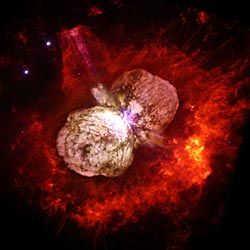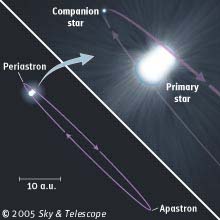
The Hubble Space Telescope captured the glory of Eta Carinae and its surrounding Homunculus Nebula. The mighty star ejected the hourglass-shaped Homunculus in vast outbursts observed in the 1800s. The star itself, and its possible companion, are buried deep within the central whitish dot.
Courtesy Nathan Smith / Jon Morse / NASA.
Astronomers describing Eta Carinae need all the superlatives they can muster. With at least 100 Suns worth of material, the blue-supergiant star is one of the ten most massive stars — if not the most massive — in the entire Milky Way Galaxy. It pumps out 5 million times more energy than the Sun, meaning it emits more light in 6 seconds than our star generates in a year. In the 1840s and '50s, the star flared up to become the second brightest in the night sky after Sirius, despite its 7,500-light-year distance. During this "Great Eruption," the star ejected at least a dozen solar masses of gas and dust — and yet somehow managed to survive.
Now a team is claiming the first direct evidence that Eta Carinae has a binary companion. Astronomers previously have been unable to detect this star for three reasons: the entire system is shrouded in vast quantities of dust, the secondary star's light is overwhelmed by the brilliance of the primary, and the two objects are separated by less than 10 milliarcseconds on the sky.
Based on previous indirect evidence, many astronomers have long suspected that a companion lurks in Eta Carinae's midst. In 1997 Augusto Damineli (University of São Paulo, Brazil) first called attention to the fact that Eta Carinae's optical spectrum undergoes changes every 5.5 years, presumably due to an orbiting star swinging behind the primary star in an elliptical orbit. Subsequent X-ray observations have lent powerful support to this picture, indicating that the winds of the two stars violently collide when the two bodies approach each other every 5.5 years.
But in a paper that has been posted on the Internet and that is scheduled to appear in the November 1st Astrophysical Journal, lead author Rosina C. Iping (Catholic University of America) and four colleagues report the direct detection of ultraviolet light from the companion. "Our observations are very solid," says Iping.
Iping and her colleagues base their conclusion on spectra taken by NASA's Far Ultraviolet Spectroscopic Explorer (FUSE) satellite. The team noticed that in June 2003, Eta Carinae's far-ultraviolet flux suddenly disappeared, presumably because the companion star had swung behind the primary and was eclipsed by its thick wind. The timing of the disappearance coincided perfectly with the predictions of the binary model.

Nobody knows the exact orbit of Eta Carinae's companion star, and it's not even proven that it exists. But if it does, it probably traces a highly elongated path nearly perpendicular to our line of sight. Every 5.54 years it comes within 2 or 3 astronomical units of the primary star — close enough that the winds of the stars collide and generate intense X-ray emissions. According to a new paper, the companion's own far-ultraviolet emission is blocked from view when the star swings behind the primary (which displays a peanut shape due to its thick polar wind).
S&T diagram by Casey B. Reed.
Iping's colleague Theodore R. Gull (NASA/Goddard Space Flight Center) adds that the Hubble's Space Telescope Imaging Spectrograph (STIS) observed a similar phenomenon at longer ultraviolet wavelengths, also indicating that the companion star's light was blocked by the primary during an eclipse. Noting that the companion star is predicted to be hotter than the primary, and should thus shine brighter in ultraviolet light, Gull stresses, "This is just the region [of the spectrum] where you'd expect to see the hot companion star if you had a chance to see it, and indeed we did see it."
"This is a great result that couldn't have been achieved without front-edge instruments like FUSE and skilled spectroscopists like the team that wrote the paper," says Damineli, who notes that the inferred properties of the companion nearly perfectly match his original predictions.
Iping says that the companion's ultraviolet spectrum has some similarities to that of a Wolf-Rayet star — the searing core of a supermassive star that has blown off most of its outer envelope in powerful winds. But she is quick to acknowledge that it could also be a normal type-O (very hot, blue) star or an O-supergiant. About all that can be said right now is that the star is very hot (at least 25,000° Kelvin, or 45,000° F). Although there is no direct mass measurement, the star probably is at least 30 times as massive as the Sun.
But not all astronomers are convinced that Iping and her colleagues have detected the companion. "There has been a succession of papers making extravagant claims about Eta Car since 1997, often with strong-sounding titles, and they've been discredited later," comments Kris Davidson (University of Minnesota).
"This is an interesting result, but I think they are jumping the gun a bit," adds Nathan Smith (University of Colorado). "I think this new paper is optimistic in unambiguously attributing the observed changes to a direct detection of the companion. It may very well be true, but I don't think we can claim to know yet."
Smith agrees that the changing ultraviolet flux probably has something to do with Eta Carinae's binary nature, but he says Iping's team failed to take into account the fact that Eta Carinae's thick stellar wind is known to be both aspherical and variable. In his view, the primary star may contribute some of the observed ultraviolet emission. Alternatively, the changing ultraviolet signatures could be emission from Eta Carinae's wind that is illuminated by the companion's ultraviolet flux. Smith and several other astronomers also point out that the secondary star inferred in the FUSE data would not generate a fast enough wind to account for the X-ray observations.
"There are still some things we need to sort out and understand, but this is an exciting result," says Gull. He asks astronomers to remain open-minded to the possibility that it was the secondary star that threw off the mass resulting in the 1840s' Great Eruption.
 0
0
Comments
You must be logged in to post a comment.